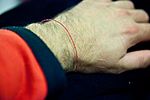List of segulot
Following is a list of popular or well-known segulot.
Fertility and childbirth
- Distributing chai rotel (about 54 liters[6]) of drink at the grave of Rabbi Shimon bar Yochai in Meron, Israel on Lag BaOmer is considered a propitious remedy for infertility, as well as for helping a person find his mate or recover from serious illness[7]
- Acting as kvatterin for a baby boy at his brit milah is a segula for childless couples to have children of their own[8]
- studying of works of Kabbalist Zera Shimshon (his only child predeceased him)[9][10]
- Eating an etrog or etrog jam facilitates an easy childbirth[11]
- Drinking from the waters of Ein Sataf in Israel prevents a breech birth[12]
Protection from harm

- Wearing a red string cut from a longer length that has been wound around Rachel's Tomb is an ancient tradition that protects the wearer from danger[13][14] The only classic source which does mention the red thread expressly forbids its use, saying that tying a red thread on one’s fingers is an idolatrous practice ("darkei emori").[15][16]
- Giving tzedakah (charity) money to a traveler to donate when he arrives at his destination helps protect the traveler from harm[17]
- Concentrating on the phrase Ein Od Milvado (Hebrew: אין עוד מלבדו, "There is none but Him [God]"[18]) shields a person from danger[19]
Marriage
- Praying at the grave of Rabbi Jonathan ben Uzziel in Amuka, Israel is considered propitious for finding one’s mate within the coming year[20]
- Praying at the Western Wall for 40 consecutive days is considered a segula for finding one’s mate[21][22]
- Holding the jewelry of a bride while she is escorted to her chuppah is a segula for finding one’s own mate[23]
Other
- Buying a burial plot is a segula for a long life[24]
- Placing a pigeon on a person’s navel is efficacious for curing jaundice[2][25]
- Giving tzedaka in the merit of Rabbi Meir Baal Hanes is a segula for finding a lost object[26]
- Buying a new knife for Rosh Hashanah is a propitious remedy for livelihood[27]
- One can hang a special note around the neck of a chicken and use it to identify a thief[28]